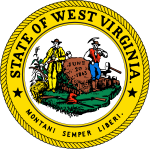| ||||||||||||||||||||||||||||||||||||||||
18 of 34 seats in the West Virginia Senate (17 regular, 1 special) 18 seats needed for a majority | ||||||||||||||||||||||||||||||||||||||||
|---|---|---|---|---|---|---|---|---|---|---|---|---|---|---|---|---|---|---|---|---|---|---|---|---|---|---|---|---|---|---|---|---|---|---|---|---|---|---|---|---|
| ||||||||||||||||||||||||||||||||||||||||
Circular inset (SD 11): Special election Democratic hold Republican gain Republican hold
| ||||||||||||||||||||||||||||||||||||||||
| ||||||||||||||||||||||||||||||||||||||||
| Elections in West Virginia |
|---|
 |
The 2000 West Virginia Senate election took place on Tuesday, November 7, 2000. State senate seats in West Virginia are staggered, with senators serving 4-year terms. 18 of the 34 state senate seats were up for election,[1] with 17 regular elections and with SD 11 holding an additional special election for Randy Schoonover, who resigned on September 7, 1999. The election took place concurrently with the presidential, U.S. Senate, U.S. House, and gubernatorial elections. While Republican candidate for George W. Bush won the state in the presidential election,[2] the Democratic Party won over 70% of the vote for state senate candidates and retained a supermajority in the state legislature's upper chamber.
- ^ Holmes, Darrell (2001). West Virginia Blue Book (PDF) (Volume 83 ed.). p. 521. Retrieved February 18, 2024.
- ^ Holmes, Darrell (2001). West Virginia Blue Book (PDF) (Volume 83 ed.). p. 747. Retrieved February 18, 2024.



